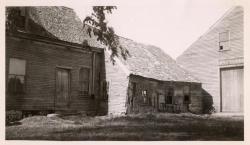Text by Charlene Fenlason
Images from Scarborough Historical Society & Museum and Rodney Laughton
A number of noted and noteworthy people have called Scarborough home at some point. Addie Kaler Vaill lived her entire life in Scarborough devoting time and energy to family and community. Henry Jocelyn arrived at Black Point in 1635 and remained involved in the early settlement for nearly forty years. And then there was Uphannum, or Indian Jane, daughter of the Sagamore of Owascoag, the Indian's name for Scarborough. Richard King, Robert Southgate, and Philip Haigis arrived in Scarborough as young men and immersed themselves in the life and business affairs of their new home. Richard King's sons, Rufus, William and Cyrus, were born and raised in Scarborough, but left to pursue education, or in William's case, business opportunities. All three became prominent in politics at the state and national level. Then we had Lewis Litchfield, station agent in Scarborough for the Boston & Maine Railroad, who had two amazing hobbies. Who hasn't heard of Winslow Homer? In his late 40s, he moved to the Prouts Neck area of Scarborough, where he drew inspiration for his famous marine paintings.
Lewis L. Litchfield
Lewis Litchfield, station agent for the Boston & Maine Railroad in the early 1900s, was born in 1871. He was a station agent first at Pine Point and later at Oak Hill. Because he felt it was his duty to care for his invalid mother, it wasn’t until he was sixty-one that he married Stella Langford of Rochester, New Hampshire.

Lewis Litchfield, Scarborough, ca. 1958
Scarborough Historical Society & Museum
As a hobby, Litchfield made high-quality bamboo fishing rods and violins. People said to have had a Litchfield fishing rod were Henry Ford, William R. Hearst and the Duchess of Windsor. A news story in the September 1, 1938 Christian Science Monitor reported that two of Litchfield’s violins were taken to the North Pole by Arctic explorer Donald B. MacMillan, a school friend of his. In 1897, he played one of his violins, made from parts of an old schoolhouse that had been on Ross Road, at the high school graduation in the Town Hall. He continued to play at the high school for over fifty years, accompanied by pianist Addie Kaler Vaill. Winslow Homer made a sketch of the violin and gave it to Mrs. Vaill who was offered a substantial sum for it. The same violin received second prize at a contest in St. Petersburg, Florida, and was later exhibited on television. In 2007 the Scarborough Historical Society acquired one of Litchfield’s violins and had it restored to playing condition. Dr. Robert Lehman, director of the strings program at the University of Southern Maine, has since performed two concerts with the violin. Quoted in an article in the Kennebec Journal Dr. Lehman said, “Ninety-nine percent of the violins made in America at the turn of the century were European. The fact that this man was able to make a classical violin without formal training and using regular carpenter’s tools is astonishing.”
Litchfield retired as a station agent at Candia, New Hampshire in 1941 and received a golden pass for his fifty years of service. Summers were spent living alone and winters with relatives in New Hampshire. In 1961, Litchfield celebrated his 90th birthday at his niece’s home in Blue Point. He died in 1963 at the age of 92 and is buried in Freeport.
Source
Scarborough Historical Society and Museum File: Lewis Litchfield

Addie Kaler-Vaill, Scarborough, ca. 1945
Scarborough Historical Society & Museum
Addie Kaler Vaill
Addie Kaler Vaill was born in 1878 to a well-known Scarborough family. She devoted her life to family and the community. Addie was involved with the public library, and she also served on the committee that erected the Soldiers Monument in Dunstan. She was chosen to unveil the statue before the largest crowd ever assembled in Scarborough. In 1936, she financed the tomb at Black Point Cemetery and established a trust fund to provide perpetual care for the entire cemetery. She also made generous contributions to the Black Point Congregational Church. Her greatest legacy was the establishment of a home for up to fifteen women residents that she and her husband, Edward Vaill, a prominent Portland businessman, had envisioned and planned. After her death in 1957 at the age of 79, her residence at 382 Black Point Road was expanded and the Kaler Vaill Memorial Home for Women was opened in 1960.
Source
Laughton, Rodney. Scarborough in the Twentieth Century . Portsmouth, NH:Arcadia Publishing, 2004.

Richard King House, Dunstan Landing, Scarborough, ca. 1930
Scarborough Historical Society & Museum
Richard King
Richard King, born in 1718 in Boston, settled in the Dunstan Landing area of Scarborough in 1746 after selling property in Watertown, Massachusetts where he’d had a successful timber exporting business. Richard bought 3,000 acres of land in Dunstan, which was divided into several farms. A successful merchant, he was also a farmer, owner of trading vessels and a town justice. The King home, built across from the marsh, was originally a one-story structure, added onto as King’s finances and family grew.
On 20 November 1753, Richard married Isabella Bragdon, by whom he had three children: Rufus, Mary and Paulina. Isabella died 19 October 1759. Three years later on 31 January 1762, he married Mary Black, a cousin of Isabella’s. Six more children were born of this union, two of whom were William and Cyrus. Three of Richard’s children, Rufus, William and Cyrus, became major public figures.
The King family prospered before the Revolutionary War. Suspected of having Tory sympathies, Richard was harassed by the Sons of Liberty and his house and financial records destroyed. Richard King died on 27 March 1775 on the eve of the Revolution.
Source
Moulton, Augustus. Grandfather Tales of Scarborough. Portland, ME: Katahdin Publishing Co., 1925.